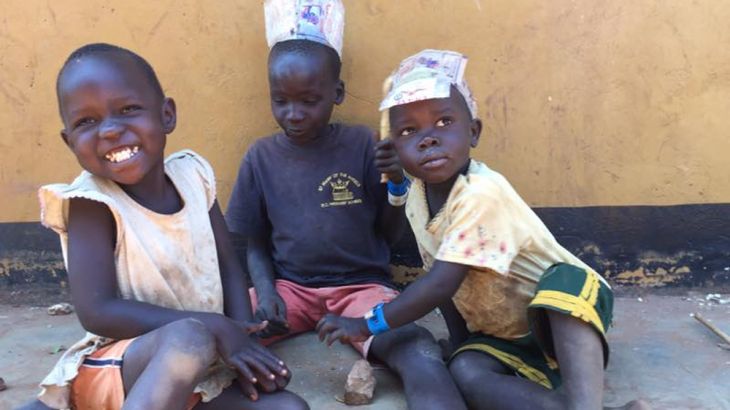Children bearing the brunt of South Sudan refugee crisis
Thousands of refugees arrive in north Uganda from South Sudan daily and many of them are unaccompanied children.

Ngomoromo, Uganda – What stands out most when you visit the Ngomoromo transit camp for South Sudan refugees in northern Uganda is the number of children.
They are all from the South Sudanese town of Pajok where clashes broke out last week between government forces and fighters from SPLM/A-IO, the main armed opposition rebel group.
Keep reading
list of 4 itemsUN report charts lethal cost of migration over past decade
Conflict, climate, corruption drive Southeast Asia people trafficking: UN
Bodies of three Rohingya found as Indonesia ends rescue for capsized boat
It is natural for children, even in the midst of misery, to play. But none of the children in the camp – not even the very little ones, was interested in any games.
Instead, they were huddled together with their families under trees in a camp that is their home for now.
When we got there, some were still wearing their school uniform. More than 580 of them were separated from their parents.
Dusty and tired, 16-year-old Agnes had just arrived when we met her. She told us she does not know where her parents or brother are.
What she remembers from Pajok are the gunshots and people running.
READ MORE: Uganda at ‘breaking point’ from South Sudan refugee crisis
One little boy, Oloo, was separating the family’s chickens. Some had died – a big loss to the family that could not salvage much else.
We also found 17-year-old Mary Amal fussing over her six younger siblings at one corner of the camp. They escaped last Monday from the area that was under the control of the rebel group before government soldiers attacked.
“We heard gunshots from a distance and then we run – everyone was running. My father refused to leave. He was killed,” she told us.
I asked where their mother was and she said that they left her hiding in the bush. Too tired to continue, she had told them she would catch up. They were still waiting for her by the time we were leaving.
These are all children who are living a life no child ever should.
![The plan by UNHCR is to move the refugees away from the border and to more established settlements [Catherine Soi/Al Jazeera]](/wp-content/uploads/2017/04/ad24015bdbd44061a07c352539edf9ce_18.jpeg)
The camp they share with their loved ones has had to be quickly adapted to accommodate the large numbers arriving as it used to be a transit centre receiving fewer than a dozen refugees on its busiest days.
Suddenly, aid bodies led by the UN refugee agency, the UNHCR, have to deal with more than 5,000 people a day with very little resources.
However, South Sudan presidential spokesman Ateny Wek Ateny has disputed the number of those displaced from Pajok.
Speaking to Al Jazeera, he said that the figures are exaggerated: Pajok has fewer than 1,000 residents, he said. The rest could be Ugandans of the same Acholi tribe trying to get free services and food.
What is not disputable though is the fact that there is little water and food in the camp.
The refugees are getting some grain, flour and high-energy biscuits from the World Food Programme. They are also being helped by relatives who live abroad.
There is not enough shelter so they are sleeping rough, in the open. Clearly, it’s no place for children to be.
![About 200,000 people have arrived from South Sudan to north Uganda since January [Catherine Soi/Al Jazeera]](/wp-content/uploads/2017/04/66b09bb4687940cb839acefee7a65f3d_18.jpeg)
The new influx worsens the refugee crisis in Uganda, the world’s fastest-growing, according to the UN. There are now more than 800,000 South Sudanese refugees across 14 camps in northern Uganda.
About 200,000 people have arrived since January and UNHCR expects 400,000 by the end of the year if the situation in their country remains the same.
To provide for the refugees, the agency desperately needs funding. The response to an appeal for $500m for refugees in Uganda has not been great. Only 15 percent of the money needed has been received from donors.
The new refugees from Pajok, like many others making their way to Uganda, say that after fighting with armed rebels that control the areas, government troops often attack the villages believing that the civilians are rebel supporters.
READ MORE: South Sudan – ‘There are only dead bodies’
“They think we are rebels because our area is controlled by rebels,” said Wadson Logata, a refugee who ran a business back home.
“But we are civilians. We don’t get to choose which armed group takes control of our villages and over our lives. We just have the power to pray that whoever it is will live with us in peace.”
The plan by UNHCR is to move the refugees away from the border and to more established settlements. Already, about 1,000 of them have been moved.
But many like Mary and her siblings would like to stay closer to the border and wait for relatives who may still be stuck in South Sudan.
She told us that she is still hopeful that her mother will show up and together they will go to live in a settlement. She does not plan to return home in the near future.
Similarly, many refugees say they are tired of living in fear and blame leaders from all sides of the conflict for failing to protect them.
![UNHCR expects 400,000 more refugees by the end of the year if the situation in South Sudan remains the same [Catherine Soi/Al Jazeera]](/wp-content/uploads/2017/04/f0093071ee9c4b10904ad3f8ae02fc65_18.jpeg)